Sphero-Conical Modeling for the Estimation of Very Long Baseline Interferometry Invariant Point
Abstract
1. Introduction
2. General Description
2.1. Project Overview
2.2. Estimation Procedure
2.3. Ground Surveying
2.4. Survey of Targets
3. Mathematical Model for IVP Estimation
3.1. Azimuthal Rotation of the Antenna
3.2. Rotation of Targets in Elevation
4. Estimation of IVP Using TLS
5. Experiments and Discussion
6. Conclusions
Author Contributions
Funding
Institutional Review Board Statement
Informed Consent Statement
Data Availability Statement
Acknowledgments
Conflicts of Interest
Abbreviations
| GHM | Gauss-Helmert Model |
| GNSS | Global Navigation Satellite System |
| IVP | InVariant Point |
| SLR | Satellite Laser Ranging |
| TLS | Total Least-Squares |
| VLBI | Very Long Baseline Interferometry |
Appendix A. The Complete Sphero-Conical Model
Appendix B. Estimation of the IVP within the Gauss-Helmert Model
References
- IERS. Available online: https://www.iers.org/IERS/EN/Science/Techniques/techniques.html (accessed on 10 August 2022).
- Altamimi, Z.; Rebischung, P.; Métivier, L.; Collilieux, X. ITRF2014: A new release of the international terrestrial reference frame modeling nonlinear station motions. J. Geophys. Res. Solid Earth 2016, 121, 6109–6131. [Google Scholar] [CrossRef]
- ITRF. International Terrestrial Reference Frame 2020. Available online: https://itrf.ign.fr/en/solutions/ITRF2020 (accessed on 28 July 2022).
- Métivier, L.; Altamimi, Z.; Rouby, H. Past and present ITRF solutions from geophysical perspectives. Adv. Space Res. 2020, 65, 2711–2722. [Google Scholar] [CrossRef]
- Sarti, P.; Sillard, P.; Vittuari, L. Surveying co-located space-geodetic instruments for ITRF computation. J. Geod. 2004, 78, 210–222. [Google Scholar] [CrossRef]
- Dawson, J.; Sarti, P.; Johnston, G.M.; Vittuari, L. Indirect approach to invariant point determination for SLR and VLBI systems: An assessment. J. Geod. 2007, 81, 433–441. [Google Scholar] [CrossRef]
- Lösler, M. Reference point determination with a new mathematical model at the 20 m VLBI radio telescope in Wettzell. J. Appl. Geod. 2008, 2, 233–238. [Google Scholar] [CrossRef]
- Dawson, J.; Johnston, G.; Twilley, B. The Determination of Telescope and Antenna Invariant Point (IVP). IERS Technical Note No. 33. In Proceedings of the IERS Workshop on Site Co-Location, Matera, Italy, 23–24 October 2003. [Google Scholar]
- Leinen, S.; Becker, M.; Dow, J.; Feltens, J.; Sauermann, K. Geodetic determination of radio telescope antenna reference point and rotation axis parameters. J. Surv. Eng. 2007, 133, 41–51. [Google Scholar] [CrossRef]
- Johnston, G.; Dawson, J.; Naebkhil, S. The 2003 Mount Stromlo Local Tie Survey; Geoscicence Australia: Canberra, Australia, 2004; 26p. [Google Scholar]
- Johnston, G.; Dawson, J. The 2002 Mount Pleasant (Hobart) Radio Telescope Local Tie Survey; Geoscicence Australia: Canberra, Australia, 2004; 21p. [Google Scholar]
- Woods, A.R. Tidbinbilla Local Tie Survey; Geoscicence Australia: Canberra, Australia, 2007; 23p. [Google Scholar]
- Yoo, S.-M.; Jung, T.; Lee, S.-M.; Yoon, H.S.; Park, H.-E.; Chung, J.-K.; Wi, S.O.; Cho, J.; Byun, D.-Y. Determination of the invariant point of Korean VLBI network (KVN) radio telescopes: First results at KVN Ulsan and Tamna observatories. J. Korean Astron. Soc. 2018, 51, 143–153. [Google Scholar]
- NGII. Enhancement of National Geodetic Network; National Geographic Information Institute: Suwon, Korea, 2019; 229p. (In Korean) [Google Scholar]
- Shen, y.; You, X.; Wang, J.; Wu, B.; Chen, J.; Ma, X.; Gong, X. Mathematical model for computing precise local tie vectors for CMONOC co-located GNSS/VLBI/SLR stations. Geod. Geodyn. 2015, 6, 1–6. [Google Scholar]
- Snow, K. Topics in Total Least-Squares Adjustment within the Errors-In-Variables Model: Singular Cofactor Matrices and Prior Information. Ph.D. Dissertation, The Ohio State University, Columbus, OH, USA, 2012. [Google Scholar]
- Bae, T.-S.; Hong, C.-K.; Lim, S.-H. Total least-squares (TLS) within Gauss-Helmert model: 3D planar fitting and Helmert transformation of geodetic reference frames. J. Korean Soc. Surv. Geod. Photogramm. Cartogr. 2022, 40, 315–324. [Google Scholar]
- Schaffrin, B.; Wieser, A. On weighted total least-squares adjustment for linear regression. J. Geod. 2008, 82, 415–421. [Google Scholar] [CrossRef]
- Geometric Reference Systems in Geodesy. Available online: https://kb.osu.edu/bitstream/handle/1811/77986/Geom_Ref_Sys_Geodesy_2016.pdf?sequence=1&isAllowed=y (accessed on 16 July 2022).
- Watson, G.A. Computing Helmert transformations. J. Comput. Appl. Math. 2006, 197, 387–394. [Google Scholar] [CrossRef]
- Zavoti, J.; Kalmar, J. A comparison of different solutions of the Bursa–Wolf model and of the 3D, 7-parameter datum transformation. Acta Geod Geophys 2016, 51, 245–256. [Google Scholar] [CrossRef]
- Andrei, C.-O. 3D Affine Coordinate Transformations. Master’s Thesis, School of Architecture and the Built Environment, Royal Institute of Technilogy (KTH), Stockholm, Sweden, 2006. [Google Scholar]
- Ioannidou, S.; Pantazis, G. Helmert transformation problem. From Euler angles method to quaternion algebra. Int. J.-Geo-Inf. 2020, 9, 494. [Google Scholar] [CrossRef]
- NGII. Standardization of Local Tie Survey Procedures; National Geographic Information Institute: Suwon, Korea, 2020; 175p. (In Korean) [Google Scholar]
- Zhang, Z.; Ma, X.; Sun, Z.; Zhang, A.; Yuan, Y.; Sun, Z. Measuring the deflection of the vertical via local reference point surveying and pointing calibration of a VLBI telescope: A case study at the Urumqi station. Earth Space Sci. 2021, 8, 1–13. [Google Scholar] [CrossRef]
- Trimble. Trimble S8 Total Station Datasheet. Available online: https://forms.trimble.com/globalTRLTAB.aspx?nav=Collection-51903 (accessed on 12 August 2022).
- Hong, C.-K.; Bae, T.-S. Characteristics of measurement errors due to reflective sheet targets - surveying for Sejong VLBI IVP estimation. J. Korean Soc. Surv. Geod. Photogramm. Cartogr. 2022, 40, 325–332. [Google Scholar]
- Snow, K. Applications of Parameter Estimation and Hypothesis Testing to GPS Network Adjustments. Master’s Thesis, The Ohio State University, Columbus, OH, USA, 2002. [Google Scholar]
- Schaffrin, B. Connecting the dots: The straight-line case revisited. ZfV 2007, 1, 385–394. [Google Scholar]
- Ghilani, C.D.; Wolf, P.R. Adjustment Computations: Spatial Data Analysis, 4th ed.; John Wiley & Sons, Inc.: Hoboken, NJ, USA, 2006. [Google Scholar]
- Schaffrin, B.; Snow, K. Total Least-Squares regularization of Tykhonov type and an ancient racetrack in Corinth. Linear Algebra Its Appl. 2010, 432, 2061–2076. [Google Scholar] [CrossRef]
- Neitzel, F.; Schaffrin, B. On the Gauss–Helmert model with a singular dispersion matrix where BQ is of smaller rank than B. J. Comput. Appl. Math. 2016, 291, 458–467. [Google Scholar] [CrossRef]
- Hong, C.K.; Bae, T.S.; Lee, S.O. Estimation of Sejong VLBI IVP point using coordinates of reflective targets with their measurement errors. J. Korean Soc. Surv. Geod. Photogramm. Cartogr. 2020, 38, 717–723. [Google Scholar]
- Amiri-Simkooei, A.R.; Zangeneh-Nejad, F.; Asgari, A. Least-squares variance component estimation applied to GPS geometry-based observation model. J. Surv. Eng. 2013, 139, 176–187. [Google Scholar] [CrossRef]
- Qian, K.; Wang, J.; Hu, B. A posteriori estimation of stochastic model for multi-sensor integrated inertial kinematic positioning and navigation on basis of variance component estimation. J. Glob. Position. Syst. 2016, 14, 1–12. [Google Scholar] [CrossRef]
- Teunissen, P.J.G.; Amiri-simkooei, A.R. Least-squares variance component estimation. J. Geod. 2008, 82, 65–82. [Google Scholar] [CrossRef]



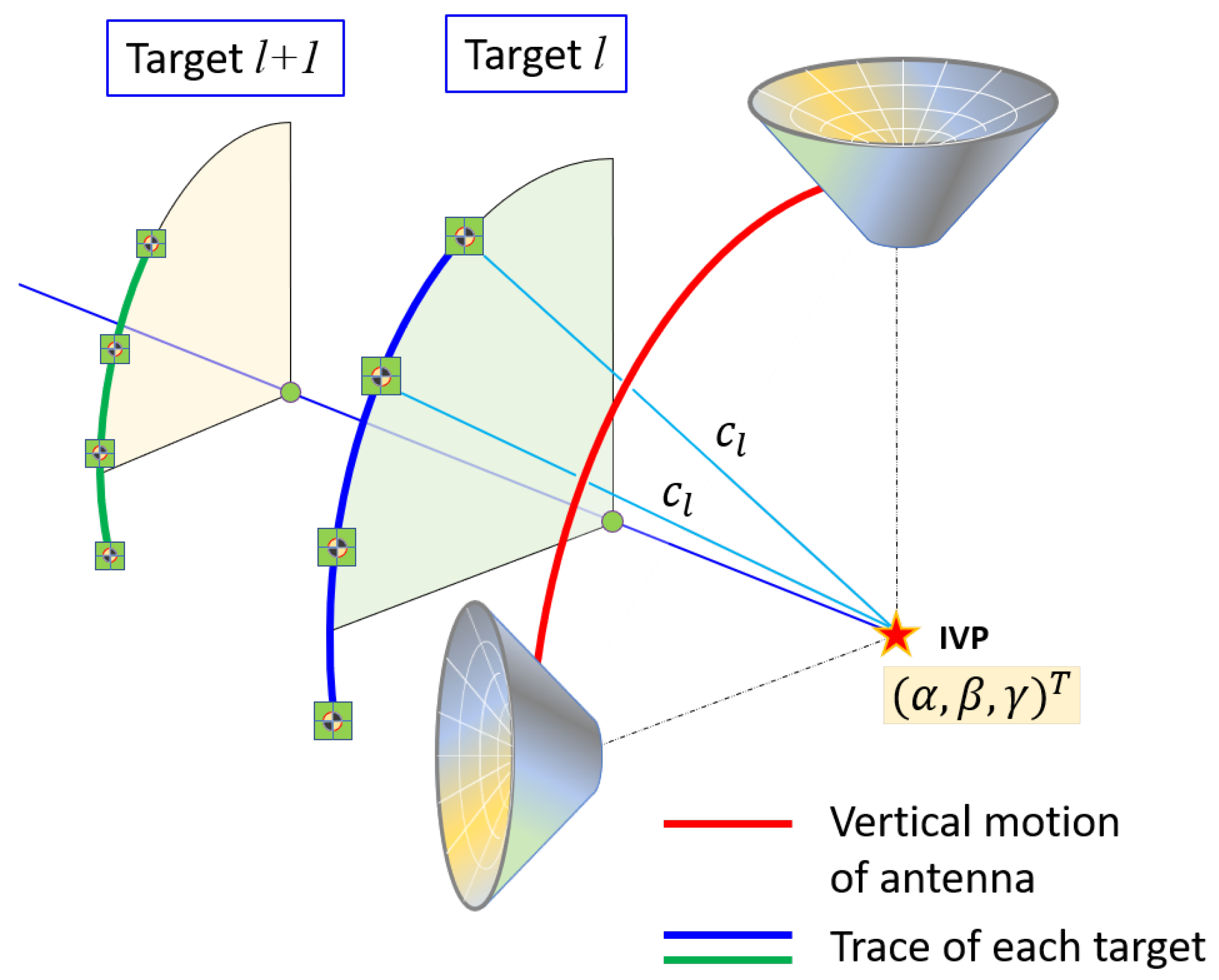
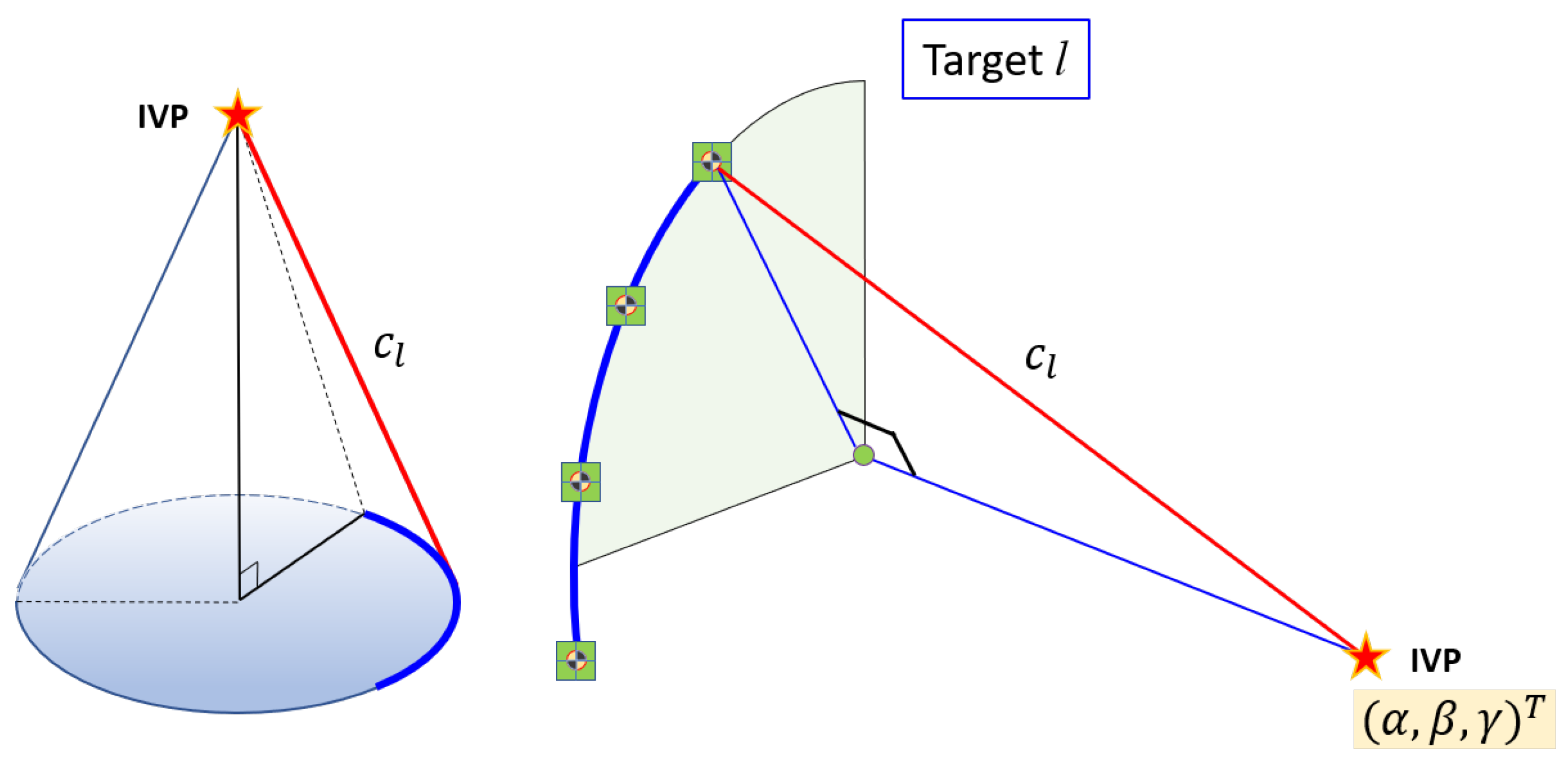
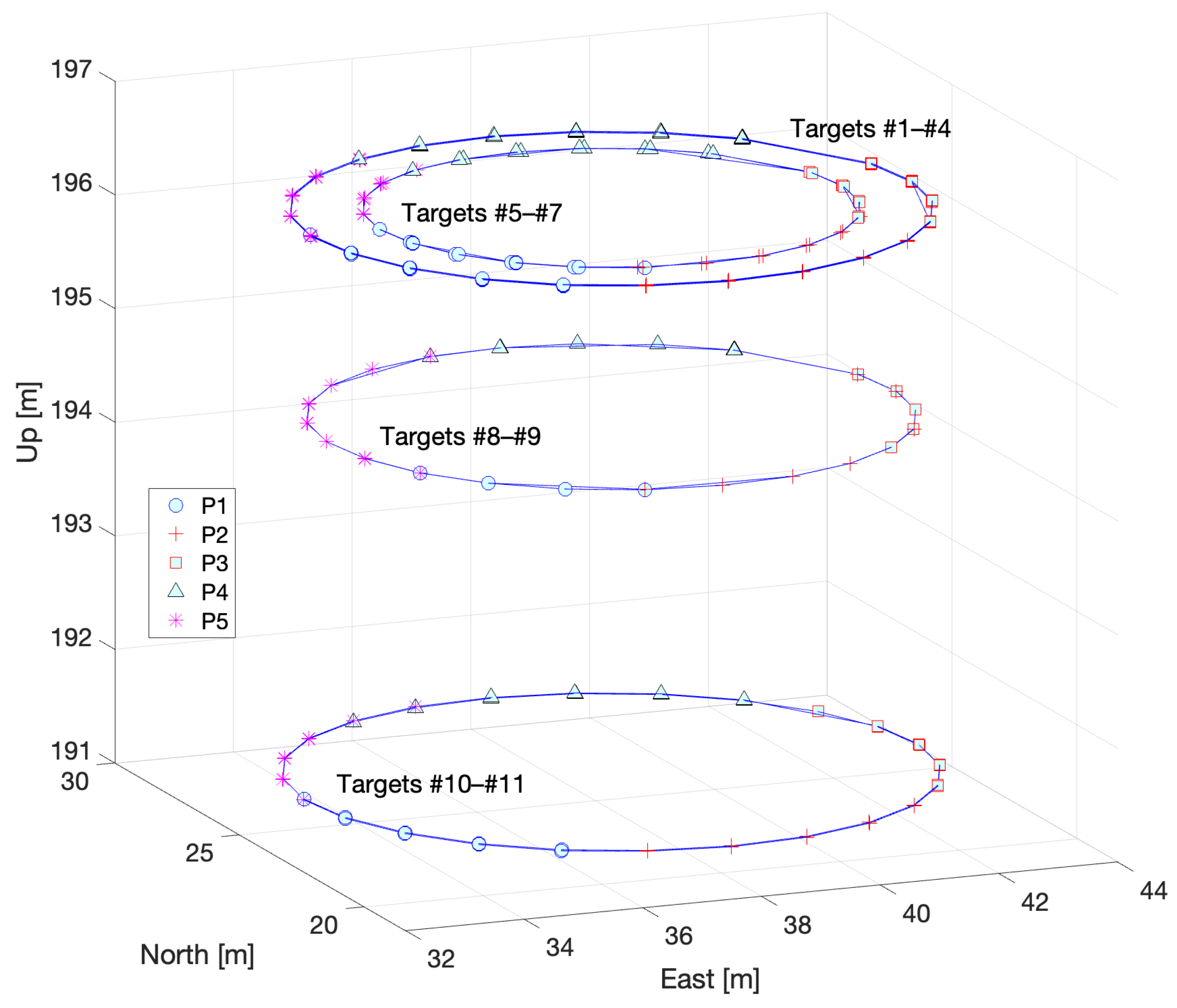

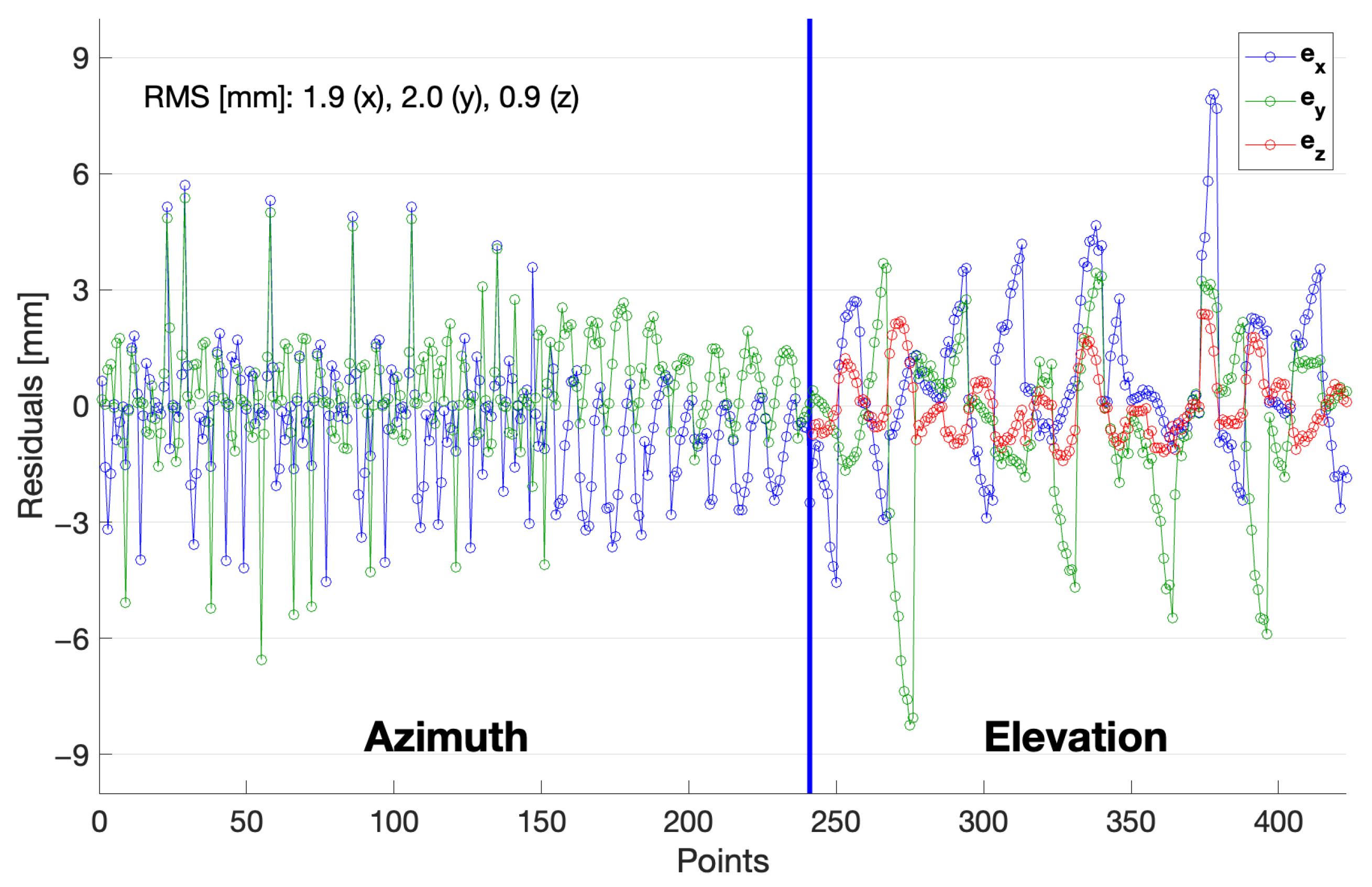
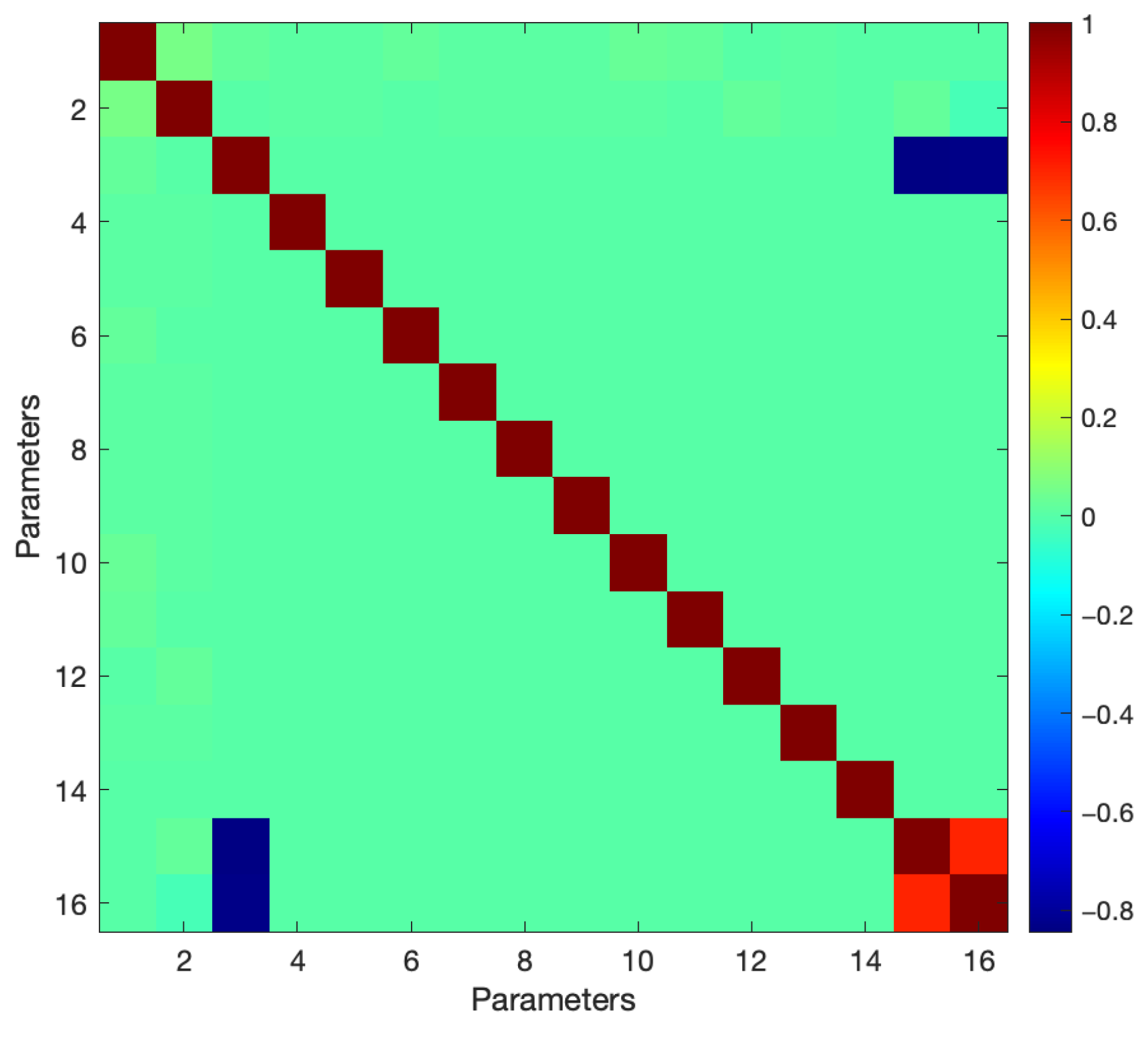
| Station | x [m] | y [m] | z [m] |
|---|---|---|---|
| VP01 | 0.0000 | 0.0000 | 177.9075 |
| VP02 | 46.5314 | 0.0000 | 180.8358 |
| VP03 | 64.9459 | 15.4701 | 180.9527 |
| VP04 | 38.0156 | 65.5444 | 180.5815 |
| VP05 | 1.0564 | 50.7578 | 185.5912 |
| SEJN | 7.1632 | −26.3145 | 181.1960 |
| est. IVP | 37.6278 | 23.4907 | 194.5977 |
| Parameter | Notation | Description |
|---|---|---|
| 1–3 | IVP where [m] | |
| 4–14 | Radii of horizontal circles | |
| 15–16 | Slant heights of a cone traced by vertical motion, with the apex at IVP |
| Iteration# | |||||||
|---|---|---|---|---|---|---|---|
| Initial | 37.6000 | 23.5000 | 194.0000 | – | – | – | – |
| 1 | 37.6300 | 23.4885 | 194.5904 | 789.1273 | 1.9389 | 0.7181 | 0.5913 |
| 2 | 37.6301 | 23.4885 | 194.5904 | 829.3425 | 2.0377 | 0.0466 | 0.0001 |
| 3 | 37.6301 | 23.4885 | 194.5904 | 829.3493 | 2.0377 | 0.0002 | 0.0000 |
| 4 | 37.6301 | 23.4885 | 194.5904 | 829.3493 | 2.0377 | 0.0000 | 0.0000 |
| [m] | [m] | [mm] | |
|---|---|---|---|
| 37.6 | 37.6301 | 0.2 | |
| 23.5 | 23.4885 | 0.2 | |
| 194.0 | 194.5904 | 1.6 | |
| 5.0 | 5.0131 | 0.6 | |
| 5.0 | 5.0166 | 0.6 | |
| 5.0 | 5.0113 | 0.6 | |
| 5.0 | 5.0112 | 0.6 | |
| 3.8 | 3.8792 | 0.6 | |
| 3.8 | 3.8801 | 0.6 | |
| 3.8 | 3.8853 | 0.7 | |
| 4.7 | 4.7489 | 0.7 | |
| 4.7 | 4.7519 | 0.6 | |
| 5.1 | 5.1275 | 0.6 | |
| 5.1 | 5.1323 | 0.6 | |
| 4.0 | 4.2939 | 0.5 | |
| 4.0 | 4.2973 | 0.6 |
Publisher’s Note: MDPI stays neutral with regard to jurisdictional claims in published maps and institutional affiliations. |
© 2022 by the authors. Licensee MDPI, Basel, Switzerland. This article is an open access article distributed under the terms and conditions of the Creative Commons Attribution (CC BY) license (https://creativecommons.org/licenses/by/4.0/).
Share and Cite
Bae, T.-S.; Hong, C.-K. Sphero-Conical Modeling for the Estimation of Very Long Baseline Interferometry Invariant Point. Sensors 2022, 22, 7937. https://doi.org/10.3390/s22207937
Bae T-S, Hong C-K. Sphero-Conical Modeling for the Estimation of Very Long Baseline Interferometry Invariant Point. Sensors. 2022; 22(20):7937. https://doi.org/10.3390/s22207937
Chicago/Turabian StyleBae, Tae-Suk, and Chang-Ki Hong. 2022. "Sphero-Conical Modeling for the Estimation of Very Long Baseline Interferometry Invariant Point" Sensors 22, no. 20: 7937. https://doi.org/10.3390/s22207937
APA StyleBae, T.-S., & Hong, C.-K. (2022). Sphero-Conical Modeling for the Estimation of Very Long Baseline Interferometry Invariant Point. Sensors, 22(20), 7937. https://doi.org/10.3390/s22207937







